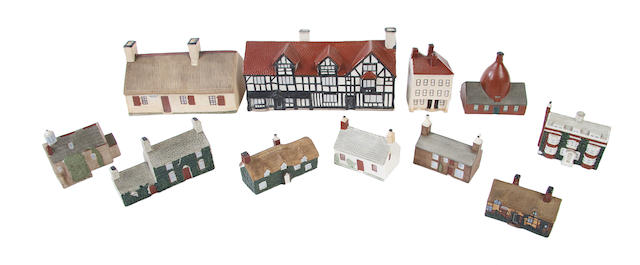 Of all the varieties of china manufactured by the firm of W. H. Goss, the cottages and other small buildings have probably the greatest appeal. They are accurately modelled, of a fine translucent body, well decorated and are not disfigured by a transfer crest. It is these two latter criteria which are used, quite arbitrarily, to define the term ‘cottage’ in this article.
Of all the varieties of china manufactured by the firm of W. H. Goss, the cottages and other small buildings have probably the greatest appeal. They are accurately modelled, of a fine translucent body, well decorated and are not disfigured by a transfer crest. It is these two latter criteria which are used, quite arbitrarily, to define the term ‘cottage’ in this article.
Pictured: Three W H Goss Cottages including the First and Last House in England, small with green door, Shakespeare’s House, small full length, one chimney damaged, and Anne Hathaway’s Cottage. Estimate £100-£150. Image Copyright Bonhams.
Plain white pieces, whether parian, or glazed with a crest, have not been included. Thus the series of lighthouses has been omitted, as have any uniformly coloured buildings. It was in 1883, just over 20 years after the founding of the firm of W. H. Goss, that the well-known heraldic china was introduced, with an eye to catching the popular market, although the more costly jewelled china and parian ware continued to be manufactured. So successful was this venture that, about 1893, Goss started a new line for his wider public, which was apparently an immediate success. This consisted initially of models of three cottages, Ann Hathaway’s, Burns’, and Shakespeare’s.
 Pictured: A WH Goss model of Robert Burns’ cottage. Estimate £60-£80. Image Copyright Bonhams.
Pictured: A WH Goss model of Robert Burns’ cottage. Estimate £60-£80. Image Copyright Bonhams.
Perhaps, at this point, there seemed little need to increase the range, and new models were at first very slow in being issued. The Manx cottage and the ‘Window in Thrums’ were issued about 1898, and in 1908 a further model, of the First and Last House at Land’s End, was produced. All these models were produced in two sizes, the larger being designed to be used as a nightlight. The choice of subject was intended to make as wide an appeal as possible and was mainly confined to well-known tourist attractions, though Goss’s liter ary interest is evident throughout, and models associated with Shakespeare, Dickens, Johnson, Wordsworth, Barry, Thomas Hardy and Izaak Walton are included.
The period from 1910 to 1915 was one of intense activity, and no less than 15 new models were announced. These, as the earlier ones, are distinguished by having a registered design number, a practice which was discontinued in July 1914.
The firm’s fortune started to decline during the First World War, but new models continued to be issued. As a group these were labelled ‘Copyright’, until about 1922, when any reference to protection of the design was omitted, although all the models were clearly labelled with the name W. H. Goss and the trademark, the Goss hawk, a kind of falcon which was taken from the family crest. In addition, every model bears a brief inscription as a form of identification. Some, particularly the earlier models, also bear an impressed mark, W. H. Goss, but this is not, as has been suggested, a reliable method of dating.
 A collection of eleven W H Goss cottages, early 20th century – Comprising two large cottages ‘Model of Burns’ Cottage’, 14.5cm wide, and ‘Model of Shakespeare’s House’, 18.5cm wide,and nine smaller examples ‘Ann Hathaway’s Cottage’, ‘Charles Dicken’s House’, ‘Prince Llewelyn’s House Beddgelert’, ‘Rt. Hon D Lloyd George’s early home Criccieth’, ‘St. Nicholas Chapel, Lantern Hill, Ilfracombe’, ‘A Window in Thrums’, ‘Old Maids’ Cottage at Lee, Devon’, ‘The House at Lichfield in which Dr Samuel Johnson was born’ and ‘Model of oven in which Goss porcelain is fired’, printed black marks. Estimate £800-£1000. Image Copyright Bonhams.
A collection of eleven W H Goss cottages, early 20th century – Comprising two large cottages ‘Model of Burns’ Cottage’, 14.5cm wide, and ‘Model of Shakespeare’s House’, 18.5cm wide,and nine smaller examples ‘Ann Hathaway’s Cottage’, ‘Charles Dicken’s House’, ‘Prince Llewelyn’s House Beddgelert’, ‘Rt. Hon D Lloyd George’s early home Criccieth’, ‘St. Nicholas Chapel, Lantern Hill, Ilfracombe’, ‘A Window in Thrums’, ‘Old Maids’ Cottage at Lee, Devon’, ‘The House at Lichfield in which Dr Samuel Johnson was born’ and ‘Model of oven in which Goss porcelain is fired’, printed black marks. Estimate £800-£1000. Image Copyright Bonhams.
The exact date of issue of the pieces is by no means easy to establish. As long as the registered design numbers were used, it is quite straightforward to find the approximate first date of issue. From 1914, the only evidence readily available is from the Goss Records, which were small catalogues listing all the so-called ‘special models’, covering heraldic ware as well as cottages, parian busts and many other types. The last two editions of these Records were issued in 1914 and 1921 with a slim supplement in 1918, so that any exact dating is impossible from the simple list of new models that was issued. The 1921 Record, for example, lists six models as being in preparation, but for the last six, no documentary evidence is available.
The lists given here represent an attempt to place the models roughly in order according to the first date of issue. With the exception of the last piece, John Knox’s house, it is likely that all the models were issued well before the firm sold out in 1929. The buyer had also acquired several other china firms, together with their moulds, and a num ber of their products were issued, marked with the Goss trademark, which had a well-deserved reputation for quality. As regards the cottages, these were mainly very inferior models of Shakespeare’s and Ann Hathaway’s cottages, in various sizes, crudely coloured and bearing the original Goss transfer label. John Knox’s house, how ever, having no counterpart in the for mer range, bears the later style of trade mark, ‘W. H. Goss, England’, which applied to new designs after 1929.
Although, as the lists show, there are only about 40 different subjects, my own collection comprises about 115 recognisably different varieties, either Because of different size, different colour, or depending on whether the models are matt or glazed. For example, of the first 17 subjects listed, that is, of those first issued up to about 1912, 15 are found both glazed and unglazed. The Newquay Look-out House, being akin to a lighthouse, and having little colour ing, is invariably glazed, while the First and Last Post Office has so far not been seen glazed, although it may well exist. None of the subsequent subjects has been found in the glazed state and it is postulated, with some supporting evi dence, that all models were issued glazed for a limited period around 1912. The glaze has the effect of protecting the paint, so that the glazed models are normally found in outstanding condi tion.
In some cases, the moulds were modified to portray actual changes made to the buildings. In the case of the First and Last House, the building was re decorated in different colours, probably around 1920, and some years later an extension was added. These changes were faithfully reproduced, and a rather scarce variety exists of it in its double length state, as it is indeed today. A half-length model of Shakespeare’s house was also issued concurrently with the normal type, also in two sizes, the larger having a loose base to allow it to be used either as a nightlight or as a pastille burner. This version is almost identical with a model issued about 50 years earlier by Copeland’s, a firm with whom Goss had been closely connected. Lloyd George’s House first appeared as a simple rectangular cottage, to which an annexe was added subsequently. Other minor varieties occur but have not been listed separately.
A further interesting sideline is to study the palette of colours used, as this changed significantly, apparently just after the First World War. Although these variations would not show up well in black and white, they are quite ob vious in practice, and many of the models are found decorated in both colours. In particular, a dark glossy red brown was changed to a pale matt brick red, and instead of a pale, grassy, green, a dark blue green was used. The most notable examples are of the Goss Oven, which naturally has a special appeal, and Dickens’ House, which is one of the commoner pieces: both can be found in the two different colours. A more subtle variation can be found in the clay which, in the latter days of the firm, was of lower quality and less translucent. This characteristic, along with the colouring, can help to date a particular specimen. The earliest models were put on sale at about Is. for the small size and 3s. for the larger. Naturally their prices rose and, by 1921, the prices quoted for even the smaller pieces was around 3s. 6d. It is doubtful whether the market value rose appreciably for some years after manufacture ceased, but they have become sought after by an increasing number of collectors during the past three years or so. Today they are not only very hard to find, but one may well be asked several pounds for even one of the commoner specimens. Of course, there are still occasional bargains to be found and I recently bought a large Burns cottage for half-a-crown, while friends have been even more fortunate and have found specimens for about ls. at church bazaars and on junk stalls. To many people, of course, these cottages are junk but, to the collector, their true worth can only be measured by the effort required for their collection and the pleasure derived from their study. In any case, to collect even a single specimen of each model listed here is by no means easy, and no doubt there are other models still to be discovered. The general pattern is that the commonest models were issued first, and the rarer last, though there are exceptions. There are two obvious reasons for this trend.
The earliest models were those with the greatest appeal, and these also had the longest life. Ann Hathaway’s Cottage must have been on sale for about 40 years. By contrast, as the list of subjects was extended, more and more obscure buildings were modelled, with a working life of a few years only. How many people have heard of the Priest’s House. Prestburv. as compared with Shakespeare’s House? Finally, the general decline of sales, from 1914 onwards, must have reduced the annual turnover steadily, and the numbers issued of the later models must have been quite small. Of the exceptions to the above trend, the larger versions of the Window in Thrums, and the First and Last House, though issued quite early on, are dis-tinctly scarce, particularly the former. All the other larger sizes are quite com-mon, and it may be that there was little interest in the Window in Thrums: even the small size is rather scarcer than its contemporaries. The models of particular interest to American customers, Sulgrave Manor and Holden Chapel, are both very scarce. The latter was sold by the agents in Boston, Massachusetts, but would probably have been obtainable from Ritchie’s, the central agents in Stoke-on-Trent. The former, with its association with George Washington, would have been especially popular with Americans, while neither would have been of out-standing interest to the average British tourist customer, apart from Goss collectors as such.





